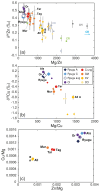Contribution of Ryugu-like material to Earth's volatile inventory by Cu and Zn isotopic analysis
- PMID: 39776490
- PMCID: PMC7617279
- DOI: 10.1038/s41550-022-01846-1
Contribution of Ryugu-like material to Earth's volatile inventory by Cu and Zn isotopic analysis
Abstract
Initial analyses showed that asteroid Ryugu's composition is close to CI (Ivuna-like) carbonaceous chondrites -the chemically most primitive meteorites, characterized by near-solar abundances for most elements. However, some isotopic signatures (e.g., Ti, Cr) overlap with other carbonaceous chondrite (CC) groups, so the details of the link between Ryugu and the CI chondrites are not fully clear yet. Here we show that Ryugu and CI chondrites have the same zinc and copper isotopic composition. As the various chondrite groups have very distinct Zn and Cu isotopic signatures, our results point at a common genetic heritage between Ryugu and CI chondrites, ruling out any affinity with other CC groups. Since Ryugu's pristine samples match the solar elemental composition for many elements, their Zn and Cu isotopic compositions likely represent the best estimates of the solar composition. Earth's mass-independent Zn isotopic composition is intermediate between Ryugu/CC and non-carbonaceous chondrites, suggesting a contribution of Ryugu-like material to Earth's budgets of Zn and other moderately volatile elements.
Keywords: CI chondrites; Cu isotopes; Hayabusa2; Ryugu; Zn isotopes; volatile elements.
Conflict of interest statement
Competing Interests Statement The authors declare no conflicts of interest.
Figures




References
-
- Lodders K. Relative atomic solar system abundances, mass fractions, and atomic masses of the elements and their isotopes, composition of the solar photosphere, and compositions of the major chondritic meteorite groups. Space Sci Rev. 2021;217(3):1–33.
-
- Morota T, et al. Sample collection from asteroid (162173) Ryugu by Hayabusa2: Implications for surface evolution. Science. 2020;368(6491):654–659. - PubMed
-
- Tachibana S, et al. Pebbles and sand on asteroid (162173) Ryugu: in situ observation and particles returned to Earth. Science. 2022;375(6584):1011–1016. - PubMed
-
- Yada T, et al. Preliminary analysis of the Hayabusa2 samples returned from C-type asteroid Ryugu. Nat Astron. 2022;6(2):214–220.
-
- Yokoyama T, et al. The first returned samples from a C-type asteroid show kinship to the chemically most primitive meteorites. Science. 2022 doi: 10.1126/science.abn7850. - DOI
Grants and funding
LinkOut - more resources
Full Text Sources
Research Materials
